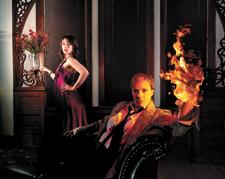Bringing to light lost lesbian stories is at the heart of award-winning local performer, director and playwright Margo MacDonald’s work these days.
Her newest piece, Shadows — chosen for this year’s Ottawa Fringe Festival — was written in an intensive three-week creation process earlier this year and details the story of lesbian theatre maven Eva Le Gallienne, whose influential work in the New York theatre scene of the ’20s, ’30s and ’40s has been all but forgotten.
MacDonald cites Le Gallienne’s homosexuality as one of the main reasons she’s been left out of the theatre canon, despite her decades of important work in the field.
“I actually stumbled across Eva Le Gallienne in a book that wasn’t about her at all, but it told a little bit about her story,” says MacDonald. “I thought, ‘This woman sounds fascinating! Why have I never heard of her?’ I asked some lesbians who work in theatre and some other people, and nobody had ever heard of her. How is this possible? She was a huge star in her day.”
In the early 1920s, Le Gallienne founded an organization in New York called the Civic Repertory Theatre (CVT) with the financial backing of one of her early lovers, Colorado goldmine heiress Alice DeLamar. Le Gallienne is said to have been disillusioned by the state of commercial theatre at the time and hoped to bring affordable, interesting shows to a broader public.
“She started the regional repertory theatre system in the United States where theatre was brought to the people and performed at affordable ticket prices,” says MacDonald. “It was the exact opposite of the Broadway system.”
CVT was arguably the predecessor of and inspiration for the creation of an international fringe festival circuit.
Though this was only one of Le Gallienne’s incredible achievements in theatre, MacDonald chose to focus the show on the relationship between Le Gallienne and her long-time lover, Josephine Hutchinson, who left her first husband in 1927 to live in a full-time relationship with Le Gallienne.
“Eva was running the Civic Repertory Theatre, and Jo was brought on as one of the actors for the company,” says MacDonald. “They worked very closely together for many months, and they just fell for each other. [Jo] was the love of her life.”
At the time, the press was delighted by the scandalous references to Le Gallienne in the divorce proceedings, and the actress was hounded and criticized by them for her queerness. Le Gallienne began to drink heavily during this period — one of the main points of contention in her relationship with Hutchinson, which lasted from 1927 to 1934.
Rather than being an exhaustive biography, the action of the play spans the years just before and immediately after a gas explosion in which Le Gallienne was disfigured and nearly killed — a tragedy that happened at the height of her career.
“[It] destroyed her hands — they had to be rebuilt — and it disfigured part of her face,” says MacDonald. “It was a turning point in her life. Although she still worked, she became very unpredictable and a little impossible to live with.”
After the accident, Le Gallienne’s demons overwhelmed her, and she struggled to keep her head above water. But through it all, says MacDonald, she produced “some of the finest theatre that New York had ever seen.”
“She was a woman who had all these amazing plans and high ideals — I found it interesting to see all the contradictions in her life. She is certainly a very passionate, interesting character.”

 Why you can trust Xtra
Why you can trust Xtra


